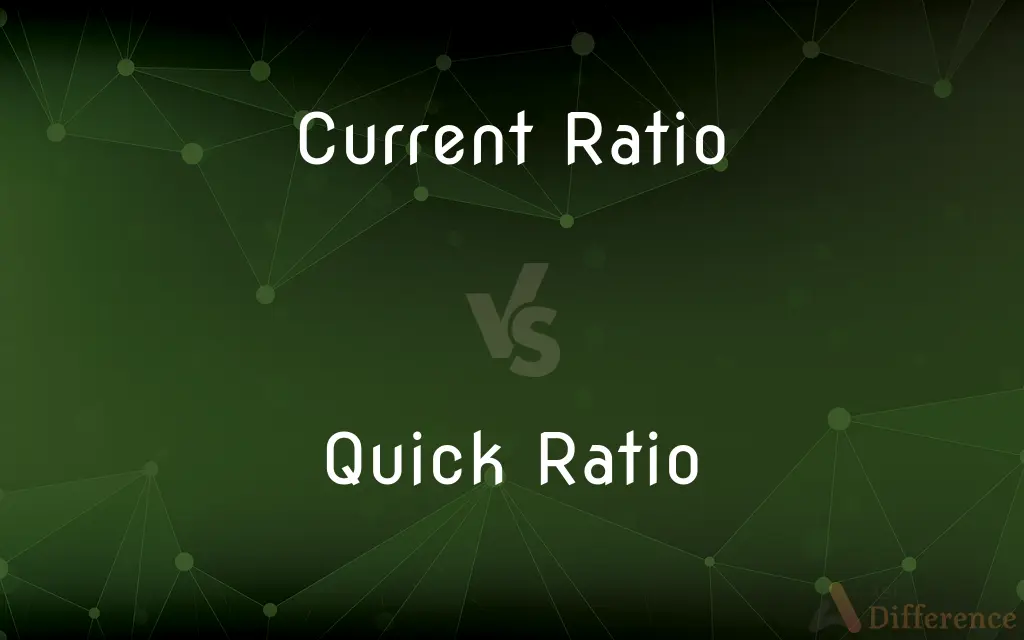Current Ratio vs. Quick Ratio — What's the Difference?
By Tayyaba Rehman — Published on November 24, 2023
Current Ratio considers all assets for measuring liquidity, while Quick Ratio excludes inventory and prepaid expenses, providing a more stringent liquidity measure.

Difference Between Current Ratio and Quick Ratio
Table of Contents
ADVERTISEMENT
Key Differences
The Current Ratio is a financial metric that determines a company's ability to cover its short-term liabilities with its short-term assets. It is calculated by dividing current assets by current liabilities. This ratio signifies a firm’s capability to pay off its obligations and is often used by analysts and investors to gauge financial stability. Conversely, the Quick Ratio, also known as the “acid-test ratio”, provides a stringent evaluation of a company’s short-term liquidity position.
The Current Ratio takes into account all current assets, which include cash, cash equivalents, accounts receivable, stock inventory, and other assets expected to be converted into cash within a year. It showcases a broader aspect of a company’s short-term financial health. In contrast, the Quick Ratio deliberately omits inventory and prepaid expenses from its calculation, focusing on the most liquid assets, such as cash and accounts receivable.
A higher Current Ratio implies that a company has more assets relative to its short-term liabilities, typically indicating solid liquidity. However, an exceedingly high ratio may suggest that assets are not being efficiently utilized to generate revenue. The Quick Ratio, on the other hand, provides a conservative view, revealing how well a company can meet its liabilities even without relying on inventory sales.
Certain industries that inherently require large amounts of inventory might have a generally lower Quick Ratio. Nevertheless, it’s considered a more accurate liquidity indicator because it doesn’t assume inventory will be quickly converted to cash. The Current Ratio, while being less conservative, provides a wider viewpoint, encompassing the overall short-term assets without distinguishing between their liquidity extents.
The aptness of using the Current Ratio or Quick Ratio might depend on the industry, company size, and financial strategy adopted by the business. An optimal level of these ratios may vary widely across different sectors and therefore, it is crucial to benchmark them against industry peers. Context is key in analyzing these ratios, as various factors including market conditions, interest rates, and sectoral challenges deeply impact a firm’s liquidity position.
ADVERTISEMENT
Comparison Chart
Grammatical Role
Used as a noun
Used as a noun
Definite Article
"The" can be used (e.g., the Current Ratio)
"The" can be used (e.g., the Quick Ratio)
Abbreviation
Sometimes abbreviated as CR
Sometimes abbreviated as QR
Example Usage
“The firm’s current ratio has improved this quarter.”
“Analysts often prefer the quick ratio for liquidity checks.”
Plural Form
Rarely used in plural form
Rarely used in plural form
Compare with Definitions
Current Ratio
The Current Ratio evaluates a company’s ability to cover short-term obligations with short-term assets.
Investors often scrutinize the current ratio to assess a company's short-term financial health.
Quick Ratio
The Quick Ratio only considers cash, cash equivalents, and accounts receivable in its calculation.
Startups might prioritize a healthy quick ratio to assure investors of sound liquidity management.
Current Ratio
The Current Ratio provides a broad view of liquidity without focusing on asset liquidation speed.
Companies with higher inventory might still showcase a strong current ratio.
Quick Ratio
The Quick Ratio can offer insights into potential financial distress if it’s persistently low.
Financial analysts raised red flags over the manufacturer's plummeting quick ratio.
Current Ratio
The Current Ratio includes cash, receivables, and inventory in its calculation.
A high current ratio may indicate the firm is not efficiently using its assets.
Quick Ratio
A higher Quick Ratio is often seen as a positive sign of a company’s short-term financial stability.
Firms in volatile markets might maintain a robust quick ratio to safeguard against market fluctuations.
Current Ratio
A Current Ratio below 1 indicates liabilities surpass assets.
The firm's current ratio of 0.8 has raised concerns among creditors.
Quick Ratio
The Quick Ratio assesses a company’s financial strength excluding inventory and prepaid expenses.
A quick ratio above 1 indicates immediate liquidity to cover liabilities without selling inventory.
Current Ratio
The Current Ratio is sensitive to inventory levels, which might not be readily convertible to cash.
Retailers, due to their inventory levels, often have varying current ratios across seasons.
Quick Ratio
The Quick Ratio is sometimes referred to as the "acid-test ratio."
The quick ratio, or acid-test, for the tech firm was notably high this quarter, signaling solid financial health.
Common Curiosities
What is the primary purpose of the Current Ratio?
The Current Ratio is utilized to assess a company's ability to pay short-term obligations using its short-term assets.
What assets are included in calculating the Current Ratio?
The Current Ratio incorporates all current assets, including cash, accounts receivable, and inventory.
Is a higher Current Ratio always better?
Not necessarily; a very high Current Ratio might indicate inefficiency in utilizing the firm's assets.
Why is inventory excluded in the Quick Ratio?
Inventory is excluded in the Quick Ratio to provide a more stringent assessment of liquidity by focusing on quickly convertible assets.
What does the Quick Ratio indicate?
The Quick Ratio provides insight into a company’s ability to meet short-term liabilities using its most liquid assets.
What is a preferable range for the Current Ratio?
Often, a Current Ratio between 1.5 and 3 is considered healthy, but this may vary by industry and company size.
Can these ratios be used to compare companies in different industries?
While useful, cross-industry comparisons may be misleading due to varying operational structures and financial practices among industries.
Is it accurate to say the Quick Ratio is more conservative than the Current Ratio?
Yes, the Quick Ratio is often deemed more conservative due to its exclusion of inventory from asset considerations.
What could a Current Ratio below 1 indicate?
A Current Ratio below 1 may suggest that the company doesn’t have enough assets to cover short-term liabilities.
Is a Quick Ratio above 1 always a positive sign?
Generally, a Quick Ratio above 1 is positive, indicating sufficient liquid assets to cover liabilities, though industry norms should be considered.
How are the Current Ratio and Quick Ratio related to liquidity?
Both ratios evaluate liquidity, but the Current Ratio considers all current assets, while the Quick Ratio focuses on more liquid assets.
Why might an analyst prefer using the Quick Ratio over the Current Ratio?
An analyst might prefer the Quick Ratio for its stringent focus on assets that can be quickly converted to cash.
How does a change in inventory affect the Current Ratio and Quick Ratio?
While the Current Ratio is affected by inventory levels, the Quick Ratio remains unchanged due to its exclusion of inventory.
Can either ratio predict the long-term viability of a company?
Neither ratio is intended to predict long-term viability as they are focused on assessing short-term financial stability.
What should be considered when evaluating these ratios?
Context, industry norms, economic conditions, and company size should be considered when evaluating the Current and Quick Ratios.
Share Your Discovery

Previous Comparison
AV Valves vs. Semilunar Valves
Next Comparison
Lose Some Pounds vs. Shed Some PoundsAuthor Spotlight
Written by
Tayyaba RehmanTayyaba Rehman is a distinguished writer, currently serving as a primary contributor to askdifference.com. As a researcher in semantics and etymology, Tayyaba's passion for the complexity of languages and their distinctions has found a perfect home on the platform. Tayyaba delves into the intricacies of language, distinguishing between commonly confused words and phrases, thereby providing clarity for readers worldwide.












































